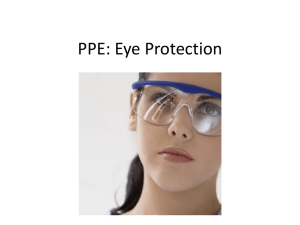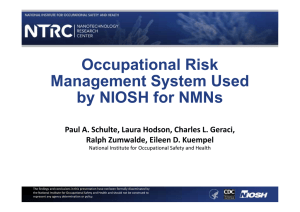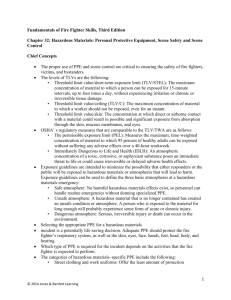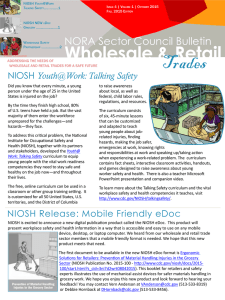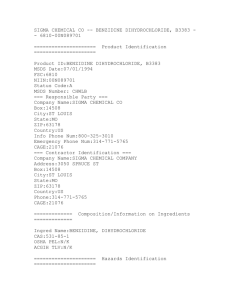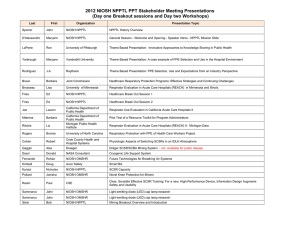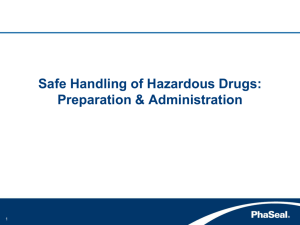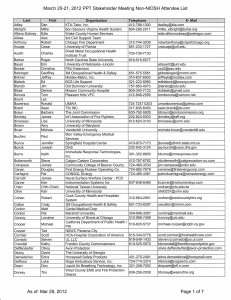Program Area Inspection Checklist
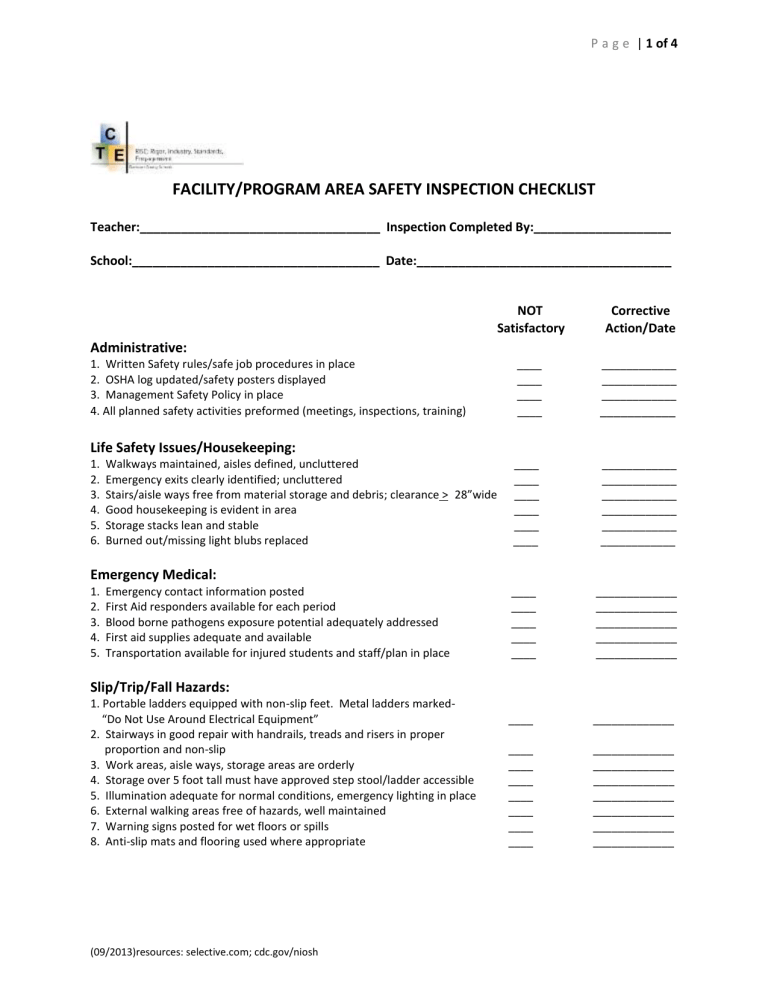
P a g e | 1 of 4
FACILITY/PROGRAM AREA SAFETY INSPECTION CHECKLIST
Teacher:___________________________________ Inspection Completed By:____________________
School:____________________________________ Date:_____________________________________
NOT Corrective
Satisfactory Action/Date
Administrative:
1. Written Safety rules/safe job procedures in place ____ ____________
2. OSHA log updated/safety posters displayed
3. Management Safety Policy in place
____ ____________
____ ____________
4. All planned safety activities preformed (meetings, inspections, training) ____ ___________
Life Safety Issues/Housekeeping:
1. Walkways maintained, aisles defined, uncluttered
2. Emergency exits clearly identified; uncluttered
____ ____________
____ ____________
3. Stairs/aisle ways free from material storage and debris; clearance > 28”wide ____ ____________
4. Good housekeeping is evident in area
5. Storage stacks lean and stable
____ ____________
____ ____________
6. Burned out/missing light blubs replaced ____ ____________
Emergency Medical:
1. Emergency contact information posted
2. First Aid responders available for each period
3. Blood borne pathogens exposure potential adequately addressed
4. First aid supplies adequate and available
5. Transportation available for injured students and staff/plan in place
____ _____________
____
____
____
____
_____________
_____________
_____________
_____________
Slip/Trip/Fall Hazards:
1. Portable ladders equipped with non-slip feet. Metal ladders marked-
“Do Not Use Around Electrical Equipment”
2. Stairways in good repair with handrails, treads and risers in proper
proportion and non-slip
7. Warning signs posted for wet floors or spills
8. Anti-slip mats and flooring used where appropriate
____
____
_____________
_____________
3. Work areas, aisle ways, storage areas are orderly ____ _____________
4. Storage over 5 foot tall must have approved step stool/ladder accessible ____ _____________
5. Illumination adequate for normal conditions, emergency lighting in place ____
6. External walking areas free of hazards, well maintained ____
_____________
_____________
____
____
_____________
_____________
(09/2013)resources: selective.com; cdc.gov/niosh
P a g e | 2 of 4
NOT Corrective
Satisfactory Action/Date
Hand Tools/Appliances:
1. Power tools/appliances properly grounded/have safety power switch
2. Defective tools/appliances are removed from service (no frayed, cut or
____
____
_____________
_____________
damaged electrical cords)
3. Proper guards are provided, tools electrically grounded or double insulated ____
4. There is a preventive maintenance/inspection program
_____________
____ _____________
5. Students/staff are trained in the safe use of hand tools/appliances ____ _____________
_____________________________________________________________________________
Fire Safety:
1. Portable fire extinguishers or proper type are mounted properly, accessible,
and inspected (nothing stored/obstructing within a 3 ft. perimeter) ____
2. Approved safety containers are used for flammable liquids ____
____________
____________
3. Combustible debris disposed of regularly i.e. oily/greasy rags stored in
a covered metal container
____ ____________
4. Compressed gas cylinders capped and chained ____ ____________
5. Sprinkler system functional/inspected/documented
6. Smoke/heat detectors functional and inspected
7. Minimum 18” clearance below sprinkler heads
8. Sprinkler valves locked open
9. Safe clearance around heaters/heat source (nothing stored/obstructing
within a 3 ft. perimeter)
____
____
____
____
____________
____________
____________
____________
____ ____________
Electrical Hazards:
1. Machinery and equipment are grounded
2. Electrical panels clear for 36” access
3. Electrical panels clearly marked (nothing stored/obstructing
within 3 ft. perimeter)
4. Outlets, switches and boxes have covers
5. Permanent wiring in place-no extension cords
6. Exposure of overhead electrical lines controlled
7. Emergency stops and critical electrical controls are identified
____
____
____
____
____
____
____
8. Appropriate electrical systems designed for hazardous locations have been
Installed in spray booths and flammable liquid storage rooms ____
9. Three (3) pronged grounded extension cords used (ground prong in place) ____
Mechanical and Manual Material Handling and Storage:
1. Hoist chains, cables, and slings are inspected regularly and documented
2. Storage piles are stable and secured from falling or collapse
3. Load limits are displayed on all hoists
4. Manual handling aids available and used
5. Weight limits set for manual lifting, carrying, pushing, pulling
6. Student/staff trained in proper lifting techniques/ergonomics
____
____
____
____
____
____
____________
____________
____________
____________
____________
____________
____________
____________
____________
____________
____________
____________
____________
___________
____________
(09/2013)resources: selective.com; cdc.gov/niosh
P a g e | 3 of 4
NOT Corrective
Satisfactory Action/Date
Machinery:
1. Lockout/tagout program in place, locks available, students/staff trained
2. Hazardous areas painted bright colors
3. Guards are provided for “point of operation” of machinery
4. Clothing and hair restrictions in place to prevent entanglement in machinery ____
5. Power transmission guards are in place ____
6. Noise exposures adequately addressed
7. Warnings displayed in obvious locations
____
____
8. Compressed air systems are not used for cleaning clothing.
9. Welding equipment in good condition
10. Compressed gas cylinders are secured to prevent falling
____
____
____
____________
____________
____________
____________
____________
____________
____________
____ ____________
____ ____________
____ ____________
11. Overhead hazards from equipment, conveyors, and process pipes, are
guarded below 7 ft. from floor ____ ____________
Chemicals:
1. Hazardous materials containers labeled (incompatible chemicals must
be stored separately)
2. Materials Safety Data Sheet (MSDS)/(SDS) available
3. Hazard Communication Training program in place
4. Chemical absorption spill control kit available
5. Eyewash/emergency shower available and functional
6. Eyewash/emergency shower flushed weekly (chart available)
7. Proper ventilation available and operational
____ ____________
____
____
____
____
____________
____________
____________
____________
____ ____________
____ ____________
Personal Protective Equipment:
1. PPE assessment performed—PPE requirements in place
2. Students/staff trained in the use and maintenance of PPE—
training documented
3. Hard hat areas designated and enforced
4. Hearing protecting utilized in required areas
5. Face/eye protection in place where needed
6. Safety foot protection required where appropriate
7. Protective clothing, gloves, aprons, boots, face shields, and
goggles are used when handling hazardous materials
8. First aid kit available
____ ____________
____
____
____________
____________
____ ____________
____ ____________
____ ____________
____ ____________
____ ____________
Inspectors Comments:
Inspector Signature:_____________________________________________Date:___________________
Teacher Signature:______________________________________________Date:___________________
(09/2013)resources: selective.com; cdc.gov/niosh
P a g e | 4 of 4
(09/2013)resources: selective.com; cdc.gov/niosh
